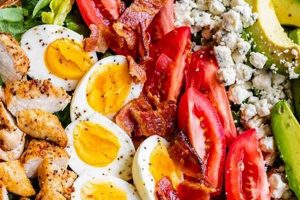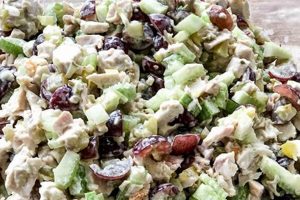A simple preparation of this dish typically involves combining drained, canned chicken with mayonnaise, celery, and onion. Variations can include grapes, apples, nuts, or dried cranberries, along with seasonings like mustard, salt, and pepper. This mixture can be served on bread, crackers, lettuce wraps, or as a filling for sandwiches and wraps.
Convenient and budget-friendly, this approach to preparing the dish offers a quick meal solution or party appetizer. Canned chicken provides a readily available protein source, eliminating the time and effort required to cook fresh poultry. This accessibility makes it a practical choice for busy individuals or those with limited cooking resources. Furthermore, its adaptability to various flavor profiles allows for customization to suit individual preferences and dietary needs. Historically, canned chicken’s rise in popularity coincided with increased demand for convenient food options in the mid-20th century, contributing to the dish’s prevalence in contemporary cuisine.
This foundational understanding of the dish’s basic components and advantages paves the way for exploring specific recipes, variations, and serving suggestions. Further exploration will cover topics such as ingredient selection, preparation techniques, and creative presentation ideas.
Tips for Preparing Chicken Salad with Canned Chicken
Optimizing canned chicken salad involves attention to ingredient selection and preparation techniques. The following tips offer guidance for creating a flavorful and satisfying dish.
Tip 1: Drain the chicken thoroughly. Excess liquid can dilute the flavor and create a watery consistency. Pressing the chicken gently with a paper towel further removes unwanted moisture.
Tip 2: Choose quality mayonnaise. Mayonnaise serves as the base of the dressing, significantly impacting the overall flavor profile. Opting for a higher-quality mayonnaise enhances the richness and creaminess of the salad.
Tip 3: Add texture with finely diced celery and onion. These classic additions provide a satisfying crunch and enhance the savory notes of the dish. Consider incorporating other textural elements such as chopped nuts or water chestnuts.
Tip 4: Season thoughtfully. Salt and pepper are essential, but experimenting with other seasonings such as paprika, garlic powder, or onion powder can elevate the flavor complexity. A touch of Dijon mustard adds a tangy kick.
Tip 5: Balance flavors with acidity. A squeeze of lemon juice or a splash of apple cider vinegar brightens the flavor profile and prevents the salad from becoming overly rich. A small amount of finely chopped dill pickle can also contribute acidity and a pleasant crunch.
Tip 6: Chill before serving. Chilling allows the flavors to meld and enhances the overall experience. Refrigerate the salad for at least 30 minutes before serving.
Tip 7: Consider variations. Explore different flavor profiles by incorporating ingredients such as grapes, dried cranberries, chopped apples, or curry powder. The versatility of chicken salad allows for endless customization.
By following these tips, one can achieve a well-balanced and delicious chicken salad that maximizes the convenience of canned chicken without compromising on flavor or texture. These foundational principles provide a strong base for culinary creativity.
With a firm grasp of these preparation techniques, the following section will explore various serving suggestions and presentation ideas.
1. Canned Chicken
Canned chicken plays a pivotal role in facilitating the ease and convenience associated with chicken salad preparation. Its ready-to-eat nature eliminates the need for cooking raw chicken, significantly reducing preparation time. Understanding the various facets of canned chicken contributes to maximizing its potential in creating flavorful and satisfying chicken salad.
- Availability and Shelf Life
Canned chicken offers widespread availability and extended shelf life, making it a practical pantry staple. This accessibility ensures that the key ingredient for chicken salad is readily available, regardless of seasonal limitations or access to fresh poultry. Its extended shelf life minimizes concerns about spoilage, providing flexibility for meal planning.
- Nutritional Content
While often perceived as less nutritious than fresh chicken, canned chicken remains a valuable source of protein. Draining the liquid reduces sodium content, aligning the ingredient more closely with dietary guidelines. Consumers can further optimize nutritional value by opting for varieties packed in water rather than oil.
- Texture and Flavor
The texture of canned chicken, characterized by its shredded or chunked form, lends itself well to incorporation into chicken salad. While the inherent flavor can be mild, this neutrality allows for greater customization through seasoning and the addition of other ingredients. The texture absorbs flavors effectively, contributing to a cohesive and well-balanced dish.
- Cost-Effectiveness
Canned chicken often presents a more economical option compared to fresh or rotisserie chicken. This affordability makes it an attractive choice for budget-conscious individuals or those seeking to minimize food costs without sacrificing protein intake.
These combined attributes of canned chickenavailability, nutritional value, texture, flavor profile, and cost-effectivenesscontribute significantly to its suitability as the primary ingredient in easy chicken salad recipes. Its convenience allows for rapid preparation, making it a practical choice for quick meals, lunches, or appetizers.
2. Mayonnaise
Mayonnaise serves as a crucial component in chicken salad prepared with canned chicken, acting as both a binding agent and a significant contributor to flavor and texture. Its properties influence the overall palatability and perceived quality of the final dish. Understanding the role of mayonnaise in this context requires exploring its various facets.
- Binding Agent
Mayonnaise emulsifies the disparate ingredientschicken, celery, onion, and any other additionscreating a cohesive mixture. This binding action prevents the salad from becoming dry and crumbly, ensuring a pleasant textural experience. The emulsification also facilitates even distribution of flavors throughout the salad.
- Flavor Enhancement
The rich, tangy flavor profile of mayonnaise complements the often-mild taste of canned chicken. Mayonnaise contributes a creamy, savory element that enhances the overall palatability. Different types of mayonnaise, such as those infused with herbs or spices, can further elevate the flavor complexity of the salad.
- Texture and Mouthfeel
Mayonnaise contributes significantly to the creamy texture and smooth mouthfeel of the chicken salad. The viscosity of mayonnaise coats the other ingredients, creating a luxurious consistency that contrasts with the potentially dry texture of canned chicken. This creaminess is essential for a satisfying sensory experience.
- Recipe Variations and Customization
The choice of mayonnaise allows for customization of the chicken salad recipe. Using plain mayonnaise provides a neutral base, while flavored varieties, such as olive oil mayonnaise or those with added herbs, introduce additional flavor dimensions. Adjusting the quantity of mayonnaise influences the salad’s consistency, allowing for variations ranging from a chunky to a smoother texture.
The careful selection and utilization of mayonnaise demonstrably impact the overall success of a chicken salad recipe using canned chicken. Its binding properties, flavor contribution, and textural influence collectively determine the final product’s quality and appeal. Understanding these facets allows for informed decisions regarding mayonnaise selection and quantity, contributing to a more satisfying culinary outcome.
3. Celery
Celery frequently appears in chicken salad made with canned chicken, contributing significantly to both texture and flavor. Its characteristic crunch offers a refreshing contrast to the softer textures of the chicken and mayonnaise, while its subtle, savory flavor complements the overall profile of the dish. Understanding celery’s role in this context requires examining its various facets.
- Textural Contrast
Celery’s fibrous stalks provide a crisp, snappy texture that counterbalances the creaminess of the mayonnaise and the softness of the canned chicken. This contrast adds complexity to each bite, preventing the salad from becoming monotonous. Finely diced celery integrates seamlessly, while larger pieces offer a more pronounced crunch.
- Flavor Enhancement
Celery’s subtle, slightly peppery, and herbaceous flavor complements the other ingredients in the salad. It adds a refreshing, vegetal note that balances the richness of the mayonnaise and enhances the savory aspects of the dish. This flavor contribution elevates the overall experience beyond a simple combination of chicken and mayonnaise.
- Nutritional Value
Celery contributes dietary fiber and essential vitamins and minerals to the chicken salad, adding nutritional value to a dish often perceived as calorie-dense. Its low-calorie content also aligns with health-conscious approaches to meal preparation. The inclusion of celery adds a healthful element to the overall nutritional profile of the salad.
- Preparation and Incorporation
The preparation of celery for chicken salad typically involves finely dicing the stalks to ensure even distribution and prevent overpowering the other ingredients. This preparation method allows the celery to integrate seamlessly into the mixture, both texturally and in terms of flavor. The quantity of celery used can be adjusted to suit individual preferences.
The incorporation of celery significantly enhances the sensory experience and nutritional value of chicken salad prepared with canned chicken. Its textural contrast, subtle flavor, and nutritional contribution elevate the dish beyond a simple combination of ingredients. Recognizing the role of celery in this context emphasizes its importance in achieving a well-balanced and satisfying chicken salad.
4. Onion
Onion plays a crucial role in enhancing the flavor profile of chicken salad utilizing canned chicken. Its sharp, pungent flavor, when used judiciously, adds depth and complexity, balancing the richness of the mayonnaise and the often-mild flavor of canned chicken. The chemical compounds within onions, particularly allium sulfur compounds, contribute to this distinct taste and aroma. These compounds undergo transformations during chopping or slicing, leading to the characteristic pungency associated with raw onions. In the context of chicken salad, finely diced onion provides a subtle bite that complements the other ingredients. For example, a classic chicken salad recipe might incorporate a quarter cup of finely diced yellow or white onion to enhance the overall savory character without overpowering the other flavors. The quantity can be adjusted based on individual preference and the desired intensity of onion flavor.
Beyond flavor enhancement, onion contributes textural complexity to the salad. Its crisp, slightly firm consistency offers a subtle contrast to the softer textures of the chicken and mayonnaise. This contrast adds a more dynamic mouthfeel, preventing the salad from becoming overly homogenous. Furthermore, onion contributes to the overall nutritional value of the dish, providing dietary fiber and various vitamins and minerals. The inclusion of onion, therefore, offers a multifaceted contribution to the final product, enhancing flavor, texture, and nutritional content.
Understanding the impact of onion on chicken salad prepared with canned chicken allows for informed decision-making regarding variety selection and quantity. Different onion varieties, such as red onion, offer milder flavors and distinct color variations, providing opportunities for customization. Careful consideration of these factors contributes to a more balanced and flavorful chicken salad experience. Overuse can lead to an overpowering pungency, whereas insufficient amounts may fail to provide the desired flavor enhancement. Striking the right balance is key to achieving a harmonious and satisfying culinary outcome.
5. Seasoning
Seasoning plays a critical role in elevating canned chicken salad from a simple combination of ingredients to a flavorful and satisfying dish. The inherent mildness of canned chicken necessitates thoughtful seasoning to achieve a well-balanced flavor profile. This process involves careful consideration of various spices, herbs, and other flavor-enhancing components to complement the existing ingredients and create a cohesive culinary experience. The interplay between seasoning and the other componentscanned chicken, mayonnaise, celery, and oniondetermines the final character of the salad.
Salt and black pepper serve as foundational seasonings, enhancing the inherent flavors of the other ingredients. Salt amplifies the savory notes of the chicken and vegetables, while pepper adds a subtle bite. Beyond these basics, a range of seasonings can further enhance complexity. Paprika, for instance, contributes a subtle smokiness and warm color, while garlic powder or onion powder intensifies the savory profile. Herbs such as dill, chives, or parsley introduce fresh, bright notes. A dash of cayenne pepper adds a touch of heat. For example, a classic chicken salad might benefit from a combination of salt, pepper, paprika, and dried dill. A more adventurous palate might appreciate the addition of curry powder or a blend of Mediterranean herbs. The choice of seasonings should align with individual preferences and the desired flavor profile.
The judicious use of seasoning significantly impacts the overall palatability and enjoyment of canned chicken salad. Over-seasoning can mask the delicate flavors of the other ingredients, while under-seasoning can result in a bland and uninspired dish. Achieving the optimal balance of seasonings requires careful consideration of the interplay between individual components and an understanding of how different flavors interact. This mastery of seasoning transforms a simple, convenient recipe into a culinary expression.
6. Bread/Crackers
Bread and crackers constitute essential components of the “chicken salad recipe easy with canned chicken” paradigm, providing both a delivery mechanism and a textural counterpoint to the salad itself. Their selection and utilization significantly influence the overall dining experience, affecting both perceived flavor and ease of consumption. Understanding the role of these carbohydrate accompaniments requires examining various facets of their contribution.
- Textural Variety
The crispness of crackers or the soft, yielding texture of bread provides a textural contrast to the creamy chicken salad. This interplay of textures enhances the sensory experience, preventing a monotonous mouthfeel. Crackers offer a pronounced crunch, while different bread types introduce varying degrees of chewiness and density. For example, a buttery cracker provides a flaky, delicate counterpoint, while a crusty baguette offers a more robust chew.
- Flavor Pairing
The flavor profile of the chosen bread or cracker interacts with the chicken salad, creating a combined flavor experience. Neutral-flavored crackers allow the nuances of the chicken salad to shine, while more flavorful options, such as seeded or herbed crackers, add another layer of complexity. Similarly, different bread types, from plain white to whole wheat or rye, can complement or contrast with the salad’s flavors. A subtly sweet bread might balance a savory salad, while a hearty multigrain bread can enhance its earthiness.
- Convenience and Presentation
Bread and crackers provide a convenient and manageable format for serving chicken salad. They facilitate portion control and portability, making them ideal for casual meals, picnics, or appetizers. Presentation also plays a role; serving chicken salad on elegantly arranged crackers can elevate a simple dish for more formal occasions. Open-faced sandwiches on crusty bread offer a more substantial meal option.
- Nutritional Considerations
The nutritional content of bread and crackers contributes to the overall nutritional profile of the meal. Whole-grain options provide dietary fiber and complex carbohydrates, adding nutritional value compared to refined white bread or crackers. The nutritional profile of the chosen accompaniment should be considered alongside the chicken salad’s ingredients to ensure a balanced meal. Choosing whole-wheat crackers or bread adds fiber and nutrients.
The selection of appropriate bread or crackers elevates the simple “chicken salad recipe easy with canned chicken” to a more complete and satisfying culinary experience. Careful consideration of textural interplay, flavor pairings, convenience, and nutritional value ensures that the chosen accompaniment enhances, rather than detracts from, the overall enjoyment of this convenient and versatile dish.
7. Quick Preparation
Quick preparation represents a defining characteristic of chicken salad recipes utilizing canned chicken, directly contributing to their widespread appeal. This attribute stems from the elimination of several time-consuming steps typically associated with traditional chicken salad preparation, such as cooking and shredding chicken. Examining the facets of this expedited process reveals its significance within the broader context of convenient meal preparation.
- Reduced Cooking Time
Canned chicken, pre-cooked and ready to use, eliminates the need for cooking raw chicken. This significantly reduces preparation time, offering a considerable advantage over recipes requiring poultry preparation from scratch. This time-saving element allows for near-instantaneous meal assembly, ideal for busy schedules or impromptu dining occasions. For instance, utilizing canned chicken reduces preparation time by at least 30 minutes compared to using raw chicken.
- Simplified Ingredient Preparation
Beyond the chicken itself, other ingredients commonly used in these recipes, such as celery and onion, typically require only minimal processing, such as chopping or dicing. This further streamlines preparation, contributing to the overall speed and ease of assembly. The absence of complex culinary techniques reduces the barrier to entry for less experienced cooks. Pre-chopped vegetables, readily available in many grocery stores, can further expedite the process.
- Minimal Equipment Required
Preparing chicken salad with canned chicken requires minimal kitchen equipment. A simple mixing bowl, a cutting board, and a knife suffice for most recipes. This lack of reliance on specialized equipment contributes to the recipe’s accessibility and convenience, making it adaptable to various settings and situations. This simplicity contrasts with recipes requiring food processors or other specialized tools.
- Adaptability to Batch Preparation
Chicken salad prepared with canned chicken lends itself well to batch preparation, further maximizing time efficiency. Larger quantities can be made in advance and stored for later consumption, providing a readily available meal option for several days. This adaptability makes it a practical choice for meal prepping or preparing food for gatherings. A single batch can provide lunches for a week or serve as a party appetizer.
The convergence of these factorsreduced cooking time, simplified ingredient preparation, minimal equipment requirements, and adaptability to batch preparationestablishes quick preparation as a cornerstone of the “chicken salad recipe easy with canned chicken” concept. This characteristic significantly contributes to the recipe’s popularity and enduring presence in contemporary cuisine, aligning with modern lifestyles that prioritize convenience and efficiency without compromising on flavor or nutrition.
Frequently Asked Questions
This section addresses common inquiries regarding the preparation and consumption of chicken salad made with canned chicken. The provided information aims to clarify potential uncertainties and offer practical guidance for optimizing this convenient and versatile dish.
Question 1: How can excess liquid in canned chicken be managed to prevent a watery salad?
Thoroughly draining the canned chicken is essential. Pressing the chicken gently with a paper towel further removes residual moisture, ensuring optimal texture and flavor concentration.
Question 2: What type of mayonnaise is recommended for achieving optimal flavor and texture?
While standard mayonnaise suffices, using a higher-quality mayonnaise, such as one made with olive oil or avocado oil, can elevate the overall richness and flavor complexity of the salad.
Question 3: How can the flavor profile of chicken salad made with canned chicken be enhanced beyond basic seasonings?
Incorporating herbs, spices, or other flavor-enhancing ingredients expands the flavor profile. Consider additions such as Dijon mustard, paprika, garlic powder, onion powder, fresh or dried herbs, or a touch of hot sauce for nuanced complexity.
Question 4: Can canned chicken salad be prepared in advance for future consumption?
Preparing chicken salad in advance is feasible. Store it in an airtight container in the refrigerator for up to three days. Note that the texture may change slightly over time as the ingredients continue to meld.
Question 5: What alternatives to bread or crackers can be used for serving chicken salad?
Beyond bread and crackers, chicken salad can be served in lettuce cups, on top of a green salad, as a filling for bell peppers or tomatoes, or used as a sandwich or wrap filling.
Question 6: How can sodium content be reduced when using canned chicken?
Opting for canned chicken packed in water rather than oil, and thoroughly draining the liquid, significantly reduces sodium content. Rinsing the chicken under cold water can further reduce sodium, although this may also slightly impact flavor.
Understanding these aspects of preparation and consumption allows for informed choices that maximize the flavor, texture, and nutritional value of this convenient dish.
The subsequent sections will delve into specific recipe variations and offer further guidance on customizing chicken salad to individual preferences.
Conclusion
Exploration of chicken salad recipes utilizing canned chicken reveals a dish characterized by convenience, adaptability, and affordability. Analysis demonstrates the essential role of each component: canned chicken as a readily available protein source, mayonnaise as the binding agent and flavor enhancer, celery and onion for textural and flavor complexity, and judicious seasoning to elevate the overall taste profile. Furthermore, the choice of bread or crackers as accompaniments contributes significantly to the complete dining experience. Addressing common preparation questions provides clarity and guidance for optimizing both flavor and texture.
This examination underscores the enduring relevance of canned chicken-based chicken salad within the culinary landscape. Its adaptability to various flavor profiles and dietary needs, coupled with its inherent simplicity and speed of preparation, positions it as a persistently practical and satisfying meal option. Further exploration and experimentation with diverse ingredients and flavor combinations offer continued potential for culinary creativity within this accessible framework.






